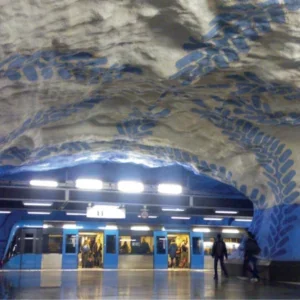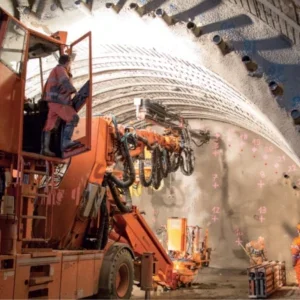The 873m long tunnel between People’s Park and Henan Mid Road is an important part of Line Two of the Shanghai metro. Both the up and down track of the section start at the east shaft of People’s Park Station and end at the west shaft of Henan Mid Road Station.
The tunnel measures 6.2m od, 5.5m id with each 1m wide tunnel liner ring composed of six segments. Both circumferential and longitudinal segment joints are connected by M30 handy-type bolts. The C50 concrete lining has an anti-penetration strength S8. Elastomeric segment gaskets are made from combined hydrophilic rubber and chloroprene rubber.
Two earth pressure balanced (EPB) shield machines, of 6.34m od and 6.54m long, were designed and manufactured in China and France for the tunnelling work.
This section of Line Two crosses People’s Square Station and Xinza Road Station of Line One near the People’s Park. Line One of the Shanghai Metro is a modern, high speed line passing through the city centre. It was completed in December 1994 and began trial operation in April 1995. Excavation of the Line One tunnel between People’s Square Station and Xinza Road Station began in April 1992 and was completed in October 1993. It used the same shield machine and segment as Line Two.
Geological conditions
The sites along the Shanghai metro lines are plane and level, at an elevation of about 3m, with ground of brown-yellow clay. The tunnel passes mainly through the layer of grey mirey clay and grey clay. The former is saturated with water, flows with soft plasticity, and is highly compressible. While the latter, also with soft plasticity, is of high to middle compressibility.
Protective requirements for running tunnel
The smooth operation of the first line train is determined by a number of technical parameters:
The construction of the east shaft of People’s Park Station has brought some effects (controlled within 10mm) on the two running tunnels. In view of the relatively long time for pore water in the clay around the tunnel to disperse, and the creeping characteristics of the soil mass, the effects of the tunnelling for Line Two must be controlled to a greater extent in order to control the final deformation of Line One within permitted values.
During the shield-machine tunnelling of Line Two, the technical parameters for the protection of Line One are a settlement and displacement < 5mm, and the relative curvature and radius of curvature of the tunnel deformation within the protective technical parameters as above.
Also, when the shield-machine on Line Two crosses under the Line One tunnel from one side to the other, a displacement in both sides of the Line One tunnel will occur. This will induce level displacements of both rails, and will affect daily operation. For the practical operation of the metro Line One the specifications are that the level deviations of both rails should be less than 4mm when the Line Two shield-machine crosses over.
Engineering difficulties
There is no similar engineering experience in China as a reference. Use of tunnelling shield machines is common, however, and from experiments, analyses and studies, ground settlement can be effectively controlled. Optimisation and matching of control parameters in shield tunnelling can be controlled to within a few millimetres. The analyses on the effects of shield machines passing under a running tunnel in close proximity are not yet mature, and there is no similar experience to use as an engineering reference.
Station excavation
The excavation of People’s Park Station on Line Two has already affected Line One and its surrounding soil with deformation. The depth of excavation of People’s Park Station is 22.12m with a minimum distance to Line One of about 10m. When excavating the pit the maximum horizontal displacement of the diaphragm wall is up to 103mm, and the displacement of the ground around the pit is also large.
Although some protective steps for Line One have been taken, the pit excavation still affected the tunnel. It can be shown that the settlement of the Line One tunnel had already reached 10mm before shield tunnelling started on Line Two, increasing the technical difficulty of the shield-machine tunnelling.
Trial tunnelling
The shield machine of Line Two commenced excavation on a trial basis with the purpose of controlling and minimising the effects on the surroundings, with respect to ground and environmental factors (such as the shield machine’s cover etc.) and through the use of monitoring data (such as soil pore pressure, amount of excavated material, tunnelling speed, etc). As the Line Two shield-machine was tunnelling on a trial basis, the construction parameters have not been adjusted to the optimum for the soil conditions, and neither have the effects on the surroundings been minimised. Under such conditions, the degree of technical difficulty must increase when the shield passes under the Line One running tunnel.
Optimal techniques for shield tunnelling parameters
The shield tunnelling parameters mainly comprise soil pore pressure, amount of spoil removed, the tunnelling speed, and the volume and pressure of grouting. Optimisation and matching of these parameters can reduce the degree of disturbance to the surrounding soil caused by shield tunnelling, and they do not operate separately from one another.
When the shield-machine passes across Line One, the following aspects should be studied:
Because Line One lies over Line Two and the soil pore pressure directly affects the deformation of the Line One tunnel, the pressure must be strictly controlled when the shield-machine passes through. Some relating parameters, such as tunnelling speed and the amount of spoil removed from the tunnel face, must be kept stable and balanced. Past engineering practice indicates that the balance is dynamic.
The soil pore pressure also fluctuates about the earth pressure because of the variation of tunnelling speed and amount of spoil removed. To reduce the deformation and settlement of the Line One tunnel, soil pore pressure fluctuation should be minimised by adjusting the tunnelling speed and amount of spoil removed.
Grouting, simultaneous with tunnelling, should be controlled both in volume and quality, as filling the construction annulus by grouting can decrease deformation of the soil mass. Grouting pressure should also be controlled reasonably, so that it fills rather than fractures the soil mass. The greater the grouting pressure, the greater will be the displacement of soil away from the lining. This is because the grout disturbs the soil mass and the liquid will be easily lost. On the other hand, the lower the grouting pressure, the slower the filling speed. Thus the grouting will be insufficient and deformation will increase. It has been proved that the grouting pressure should be controlled to within 1.1-1.2 times the static earth pressure.
The position of the shield machine should be strictly controlled. Changing of its position should not be too large or frequent so that loss of ground and disturbance to the surrounding soil can be minimised. This will also reduce the settlement of the Line One tunnel and of the tunnel being driven.
To maintain good control of Line One tunnel deformation, the shield tunnelling progress must be kept balanced. Also, the time period for the shield passing through the zone of Line One tunnel should be minimised to reduce the effects on the existing tunnel.
In the course of adjustment and optimisation of shield tunnelling parameters, monitored data needs to be collected over time. It is used to realise the required information for construction.
Construction data techniques based on monitoring and feedback
In the major engineering task of the crossing of Line Two by Line One, construction information based on monitoring feedback and analyses is particularly important because there is no theoretical instruction or practical experience in existence. During the shield-machine tunnelling for Line Two, the reaction of the Line One tunnel structure is very sensitive to deformation because the distance between the two is so short.
Only by means of construction information from monitoring and feedback could the safety and normal operation of Line One, and timely crossing of the Line Two shield-machine, be guaranteed. For the Line Two shield machine to pass across Line One, the specific methods are as follows:
Complete monitoring data should be gathered. In order to obtain this data and protect the safety and normal operation of Line One, the line is monitored and the deformation of it is portrayed completely. The monitoring functions are mainly as follows: vertical settlement; horizontal displacement; level deviation of both track rails; and restraining deformation of the tunnel section.
To obtain the settlement data of Line One, feedback and direction of Line Two shield tunnelling, the connected tubes for monitoring are placed in the up and down tracks of Line One, to gather the data quickly and precisely.
In order to gather information on construction and ensure this data is gathered at the right time, many kinds of communicating instruments are used in the shield-machine tunnelling of Line Two crossing under Line One. The construction parameters of shield-machine tunnelling are transmitted to a data processor for analysis and commands sent back to direct the shield-machine. In the course of the crossing the data is analysed so that, if the deformation is too big and the speed too high, the adjustment commands will be used to direct the shield-machine.
It is emphasised that the shield-machine must cross slowly while Line One is in operation. The deformation data collected automatically is particularly important to present a picture of the construction information. A series of apparatuses is used for automatic monitoring.
Line One reinforcement
The reinforcement and protective measures on Line One are both important. These consist of two aspects:
Analysis of practical results
Direct apparent results are obtained by means of the above technical measures. Firstly, the safety of Line 1 and the trains’ daily operation are ensured during the crossing by shield-machine tunnelling. Secondly, smooth crossing of the Line Two shield-machine is guaranteed. The settlement curve of the Line One tunnel following the crossing of Line Two. Shows the settlement "history" at the crossing point of the "down" track of Line One and the "up" track of Line Two. This shows that, during the course of the Line Two crossing, the settlement of Line One is not more than 5mm. The deformation of the section of "down" track of Line One, before and after the crossing of Line Two. This shows that the deformation of this section is not large. The maximum diametrical deformation is about 5mm; not more than the allowed design standard.
Conclusion
With the development of the Shanghai Metro construction, there will be more and more cases of engineering needed for shield-machines passing through the line of a running tunnel in close proximity. Phase 2 of Pearl Line in Shanghai, which is to be constructed, is of half-ring section. It will cross many completed tunnels, and there will be several stations with the same transfer platforms. Consequently, more problems will be encountered with shield-machine tunnelling in close proximity to existing tunnels, so it is extremely urgent to solve the problem.
Related Files
Longitudinal settlement
Crossing zone of the “down” track






